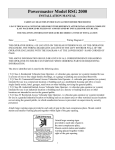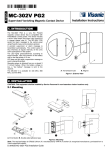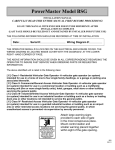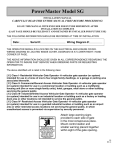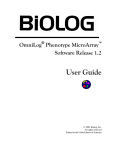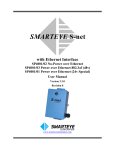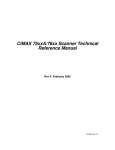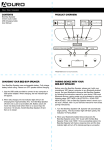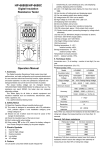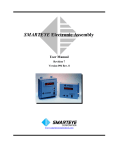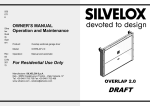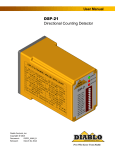Download Manual - Gates N Fences
Transcript
TABLE OF CONTENTS MODEL “SBG” PowerMaster SINGLE ARM BARRIER GATE OPERATOR Important Safety Information……………..…………….......3 System Designer Safety Instructions……...…….……..........4 Installer Safety Instructions …………...………………....….. 5 End User Safety Warnings …….….…………………….8-10 Installation & Setup Procedure Before Installing Operator……..…………..……...………11 Installation of Cement Pad………......………..…………...12 Installation of Operator………………..……….…....13-14 Installation of Barrier Arm…...………………………..15-16 Electrical Connections………………..………………16-17 Clutch Adjustment……………..………….……………....18 Manual Operation………………….…..………….……....19 Limit Adjustment Procedure ………… …….…….…..19-20 Accessory Connections Connection of a 2 Button……….………..…….……….…21 Connection of a 1 Button……….….……….……….…….21 Connection of a Radio………….….………………...….…22 Timer To Close……….…………………….…….….……23 External Timer Defeat Switch ………….…………………24 Auxiliary Limit Switch ……..…….…...………….………24 Master/Slave Operation………..……………..…..........25-27 Installation of Edge Sensor or Photo Eyes…….….…..…...28 Installation Manual SINGLE ARM BARRIER GATE OPERATOR UL 325 AND UL 991 LISTED UL Loop Detector Systems and Installation Loop Layout Diagram….………….…..……….…….…….29 Standard Loop Layout Size Chart…………….....................30 Loop Installation………………………..……..………..….30 Cutting The Required Groove………...………...................31 Loop Detector Connections…………………….…………....32-34 Barcon Board Overview…………………………………...35 Wiring Diagram………………………………..…..............36 Notes/Maintenance Log…….………….………..................37 Warranty……………………………..…………………….38 R 2 IMPORTANT! FOR BARRIER GATE OPERATING SYSTEMS SAFETY IS EVERYONE’S BUSINESS Automatic gate operators provide convenience and security to users. However, because these machines can produce high levels of force, it is important that all gate operator system designers, installers, and end users be aware of the potential hazards associated with improperly designed, installed, or maintained systems. Keep in mind that the gate operator is a component part of a total gate operating system. The following information contains various safety precautions and warnings for the system designer, installer and end user. These instructions provide an overview of the importance of safe design, installation, and use. Warnings are identified with the ▲ symbol. This symbol will identify some of the conditions that can result in serious injury or death. Take time to carefully read and follow these precautions and other important information provided to help ensure safe system design, installation and use. SYSTEM DESIGNER SAFETY INSTRUCTIONS ▲ 1. Familiarize yourself with the precautions and warnings for the installer. Users are relying on your design to provide a safe installation. The installation should have an entrapment protection system installed such as photoelectric sensors or an electric edge. ▲ 2. When designing a system that will be entered from a highway or main thoroughfare be sure the system is placed far enough away from the road to eliminate traffic backup. Distance from the road, size of the gate, usage levels, and gate cycle/speed must be considered to eliminate potential traffic hazards. ▲ 3. Design the gate system so a person cannot be trapped between the arm and any other fixed structure. All rigid objects must be at least 2 feet from gate arm. 2 FEET ▲ WARNING: Gate operators are only one part of a TOTAL GATE OPERATING SYSTEM. It is the responsibility of purchaser, designer, and installer to ensure that the total system is safe for its intended use. All secondary entrapment safety devices must be RECOGNIZED by U/L to ensure the safety of the complete operating system. 3 4 INSTALLER SAFETY INSTRUCTIONS BEFORE INSTALLATION ▲ 1. Check to see that the operator is proper for this type and size of opening and its frequency of use. If you are not sure, consult factory. ▲ 2. Check to see that there are no structures adjacent to the area, which may pose a risk of entrapment when gate is opening or closing. DURING INSTALLATION ▲ 1. Be aware of all moving parts and avoid close proximity to any pinch points. ▲ 2. Disconnect power at the control panel before making any electric service connections. Connection location for controls and safety equipment can be found on the wiring diagram, and in this manual. ▲ 3. Locate the controls at least 10 feet from the moving gate so that the user can observe the gate operation, but is not able to come in contact with the gate while operating the controls. ▲ 3. Safety equipment such as electric edges or photocell sensors must be installed to provide personnel, equipment, and property protection. For assistance in selecting the correct type of safety equipment, consult the factory. ▲ 4. You must install a pushbutton control or key switch to allow for normal operation of the gate if the automatic controls do not work. Locate the pushbutton or key switch and small warning placard within sight of the gate in a secured area at least 10 feet or more from the gate and fence to keep users away from the moving gate and fence. ▲ 5. Outdoor or easily accessed gate controls should be of the security type to prohibit unauthorized use. 10 FEET 5 6 AFTER INSTALLATION END-USER SAFETY WARNINGS ▲ You are responsible for ensuring that the end user understands the basic operations and safety systems of the unit, including the proper way to disengage and manually operate this unit. ▲ Point out that the safety instructions in this brochure are the responsibility of the end user, and then LEAVE THIS BROCHURE WITH THE END USER Be sure you’ve been fully instructed on the sequence of operation for your specific gate system(s). Keep the gate properly maintained and have a qualified service person make repairs. ▲ 1. Be sure the following safety instructions are distributed to all persons authorized to use your gate. ▲ 2. KEEP GATEWAY CLEAR AT ALL TIMES. Your automatic gate is not for pedestrian use. No one should ever cross the path of the moving gate. 7 8 ▲ 3. DO NOT allow children to play near your gate, or to operate the gate. ▲ 7. Be sure the gate arm DOES NOT come within 2 feet of any rigid object, therefore causing an entrapment situation. 2 FEET 10 FEET ▲ 4. DO NOT operate your gate system unless you can see it when the gate moves. ▲ 5. Be sure a pushbutton or key switch has been installed for manual electric operation in the event your radio or card does not work. Any mounted control station should be located a minimum of 10 feet from the gate so the gate cannot be touched. Any pushbutton located in a building should be installed within sight of the gate. ▲ 6. DO NOT operate any controls without watching the movement of the gate. 9 ▲ 8. If your gate closes automatically, loop detectors should be installed to detect the presence of a vehicle. ▲ 9. If a contact or non-contact safety system has been installed check for proper operation at least once per month. If these functions are observed to operate improperly, discontinue use and have it serviced immediately! ▲ 10. To ensure safe operation of this equipment, you must read this safety manual and keep it for reference. 10 INSTALLATION INSTRUCTIONS WARNING: DO NOT APPLY POWER UNTIL TOLD TO DO SO! RISK OF ELECTRICAL SHOCK OR INJURY MAY RESULT! INSTALLATION OF CEMENT PAD 1. Install a mounting pad as shown below. WARNING – Install operator mounting pad so moving arm will always be at least 2 feet from any fixed object. BEFORE INSTALLING OPERATOR 15-1/2" IMPORTANT: 13-3/4" (MOUNTING BOLTS) 1. Operator should always be mounted inside the gate. 2. All controls are to be mounted at least 10’ from the gate arm. 16" MIN. 2 FEET 8" ELECTRICAL ACCESS 9-3/4" (MOUNTING BOLTS) ELECTRICAL CONDUIT FOR POWER SUPPLY ELECTRICAL ACCESS 24" MIN. 1/2" ANCHOR BOLTS GROUND LEVEL 4" MIN. 1-1/2" MIN. 2" 24" MIN. 10 FEET ELECTRICAL CONDUIT FOR POWER SUPPLY 3. Allow at least 2 feet clearance from rigid objects to gate arm. 11 Note: Let cement cure for two days before proceeding. 12 INSTALLATION OF OPERATOR 1. Remove top cover as follows: • • • Insert key provided and unlock top cover lift cover from lock side and slide forward lift off cover 3. Mount operator on pad so that mounting bolts locate in operator base frame mounting holes and operator is parallel to fence line. (See diagram below.) 4. Secure operator to cement using ½” flat washers, lock washers and hex nuts as shown in diagram. 2. Remove side door of operator by reaching inside operator and unscrewing retaining knob at top of door. After removing retaining knob, push out top of door and lift away from operator. See diagram below. TOP COVER EXTERIOR COVER KEY 1/2" HEX NUT (4) 1/2" LOCK WASHER (4) SIDE COVER RETAINING KNOB 1/2" FLAT WASHER (4) DRIVE FRAME ANGLE SIDE DOOR (4) 3/8" NUTS CEMENT PAD (4) 3/8" LOCK WASHERS (4) 3/8" FLAT WASHERS POWER HEAD 2" U-BOLTS MOUNTING BOLTS NOTE: REDUCER AND MOTOR NOT SHOWN FOR CLARITY. 2" PIPE 13 14 INSTALLATION OF BARRIER ARM For 8’, 10’, or 12’ Arms 1. Install arm cap using (4) ½ x 1-1/2” long hex bolts, lock washers and nuts as shown below. Do not tighten until told to do so. 4. Mount counter weight on weight carrier bracket using (2) ½” x 4” long hex bolts, lock washers and nuts as shown in diagram. Be sure to use holes in weight carrier bracket as shown in diagram for proper arm balance. OPERATOR OUTPUT SHAFT ARM MOUNTING FLANGE 2. Insert large end of wood arm into arm cap until flush with opposite edge of arm mounting flange. 3. Adjust arm to the desired horizontal position and secure by tightening the 1/2” mounting hardware. ARM 1/2" NUT (4) OPERATOR OUTPUT SHAFT ARM MOUNTING FLANGE 1/2" x 1-1/2" HEX BOLT (4) 1/2" LOCK WASHER (4) ARM 1/2" NUT (4) 1/2" LOCK WASHER (4) 1/2" x 1-1/2" HEX BOLT (4) 1/2" NUT (2) 1/2" LOCK WASHER (2) WEIGHT CARRIER BRACKET ARM CAP 1/2" X 4" LONG HEX BOLT (2) COUNTER WEIGHT NOTE: USE MOUNTING HOLES SHOWN ABOVE TO MOUNT COUNTER WEIGHT FOR PROPER BALANCE OF 14 FOOT OR 16 FOOT ARMS. Electrical Connections For 14’, and 16’ Arms 1. Install weight carrier bracket using (4) 1/2 x 1-1/2” long hex bolts, lock washers and nuts as shown below. Do not tighten until told to do so. 2. Insert large end of wood arm into weight carrier bracket until it hits stop. 3. Adjust arm to the desired horizontal position and secure by tightening the 1/2” mounting hardware. 15 WARNING- DO NOT APPLY POWER UNTIL TOLD TO DO SO. RISK OF SHOCK OR INJURY MAY RESULT! NOTE: Wiring to operator must use watertight materials in accordance with local electric code. See wire gauge/distance charts for proper sizing. Master/Slave installations should have SEPARATE power supply wiring or length of wire runs should be figured at half that shown on the chart. This unit must be grounded in accordance with N.E.C. and local codes. 16 Before connecting the operator, use a voltmeter to determine that the electrical service is 115V. THIS OPERATOR CANNOT BE CONNECTED TO 230 VOLTS. Damage will result which is not covered under warranty. CLUTCH ADJUSTMENT Note: The clutch is set to the lightest setting at the factory and will require adjustment for proper operation. 1. Remove top cover and side door. Line Voltage HP 14 AWG 12 AWG 10 AWG 8 AWG 6 AWG 115 VAC 1/2 150’ 250’ 400’ 500’ 650’ Note: Before starting clutch adjustment, turn off power switch on electrical panel, and set all four adjusting nuts on clutch to the same position. 2. To tighten clutch, turn the four adjustment nuts, as shown below, 1/4 turn at a time, in a clockwise direction. 1. Be sure power switches at source and in operator are OFF. 2. Connect incoming power lines and ground wire as shown below. Hot leg (black) to BLACK; Neutral (white) to White: Ground to GREEN OPERATOR UTILITY BOX BLK BLK WHT WHT GRN GND INSIDE UTILITY BOX, CONNECT AS SHOWN L O W V O L T A G E W IR E G A U G E /D IS T A N C E C H A R T 24 AW G : 20 A W G : 18 AW G : U p to 1 5 0 ' 150' - 200' 2 5 0 ' - 1 ,5 0 0 ' INCOMING POWER 115V - 1Ø CLUTCH ADJUSTMENT NUTS CLUTCH ADJUSTMENT NUTS 3. Replace side door to activate power interlock. 4. Turn on power switch on electrical panel. 5. Test barrier gate operation using the OPEN/CLOSE control switch located on the electrical panel. TIMER TO CLOSE ON/OFF SWITCH OPEN/CLOSE CONTROL SWITCH 24 VOLT OVERLOAD 110 VOLT OVERLOAD ON/OFF POWER SWITCH C o n tr o l w ir in g s h o u ld b e r u n a s tw is t e d p a ir s . D O N O T r u n c o n t r o l w ir e s in t h e s a m e c o n d u it a s p o w e r w ir e s . te le p h o n e w ir e s , o r lo o p d e t e c t o r le a d s . 17 18 6. Observe clutch during the start of the OPEN cycle to determine if clutch is slipping. 7. Repeat adjustment procedure, step #1 - #4 until there is no clutch slippage when operator starts the OPEN cycle. 1. In order to achieve 90 degree arm movement from the drive linkage, the limit cams must be set to obtain the linkage positions shown below. UPPER CONTROL ARM UPPER CONTROL ARM DRIVE LINK MANUAL OPERATION 1. Remove top cover, and side door. DRIVE LINK ▲ WARNING: TO AVOID INJURY, TURN OFF POWER LOWER CONTROL ARM SUPPLY SWITCH TO OPERATOR BEFORE MAKING ANY ADJUSTMENTS. 2. Loosen adjustment nuts on drive clutch. Turn clutch to raise or lower gate arm. 3. To return to powered operation re-adjust clutch as shown in clutch adjustment section. 4. Turn on supply power to operator. Replace side door and top cover. LIMIT ADJUSTMENT PROCEDURE LOWER CONTROL ARM DRIVE LINKAGE IN HORIZONTAL ARM POSITION (DRIVE LINK AND LOWER CONTROL ARM STRAIGHT IN LINE) DRIVE LINKAGE IN VERTICAL ARM POSITION (DRIVE LINK AND LOWER CONTROL ARM FOLDED TOGETHER IN LINE) 2. To set limit cam, loosen set screw and rotate to desired position then tighten set screw. ACTUATING SCREW WARNING: TURN OFF POWER SUPPLY BEFORE MAKING ANY ADJUSTMENTS. LIMIT SWITCH NOTE: The drive linkage geometry prevents more than a 90 Degree gate arm movement. (Horizontal to Vertical position.) SET SCREW LIMIT CAMS LIMIT CAM SIDE VIEW CLOSE LIMIT SWITCH VERTICAL 90o OPEN LIMIT SWITCH AUX. LIMIT SWITCH HORIZONTAL Note: Limits are set for 90 degree arm movement at factory. 19 20 3. If a shorter stroke than 90 degrees is desired at either end, limits may be reset to achieve this. 4. If the limit cams are adjusted correctly and the operator is maintaining 90 degree rotation but the arm is not horizontal in the down position; loosen the (4) mounting bolts, adjust arm and retighten mounting bolts. RADIO CONTROL INSTALLATION 1. Mount radio receiver in cabinet of operator. A mounting bracket has been provided which may be used to directly attach many commonly used radio receivers as shown below. CONNECTION OF A 2 BUTTON STATION NOTE: All Control contacts must be NORMALLY OPEN. • • • Connect “COMMON” to Terminal #5. Connect “OPEN” button to Terminal #6. Connect “CLOSE” button to Terminal #7. 1 2 COMMON OPEN CLOSE 3 4 5 NOTE: For radios supplied with a coax cable and antenna, longer radio range may be obtained by drilling a 3/8” diameter hole through the operator cabinet and mounting antenna outside the operator. 6 7 8 9 10 A Three or Four wire radio control receiver can be installed on this operator. See the diagrams below for the correct connections to match your installations equipment and desired functions. CONNECTION OF A 1 BUTTON STATION NOTE: If your radio’s connecting wires are not color coded as shown, see the radio’s installation manual to determine which wires are for the normally open contacts and which require the 24 VAC Power Supply. NOTE: Control contacts must be NORMALLY OPEN. 1. Connect one wire from the single button control to terminal #1 on the operator terminal strip. 2. Connect the second wire from the single button control to terminal #2 on the operator terminal strip. 4 WIRE RADIO CONNECTION 1 2 1 3 4 N.O. CONTACT 4 WIRE RADIO 24 VAC 21 3 WIRE RADIO CONNECTION GY GY BK R 2 3 1 4 R1 N.O. CONTACT 3 WIRE RADIO R2 R3 POWER R4 22 2 3 4 TIMER TO CLOSE OPTION The operator is equipped with a timer to close option for use with other control devices such as a radio control, or card key control. EXTERNAL TIMER DEFEAT SWITCH CONNECTION 1. Connect the two wires from the normally open terminal of the external ”Timer Defeat Switch” to terminals #9 and #10 as shown in diagram. TIMER TO CLOSE ON/OFF SWITCH TIMER TO CLOSE ON/OFF SWITCH OPEN/CLOSE CONTROL SWITCH 24 VOLT OVERLOAD OPEN/CLOSE CONTROL SWITCH 24 VOLT OVERLOAD 110 VOLT OVERLOAD 7 110 VOLT OVERLOAD ON/OFF POWER SWITCH ON/OFF POWER SWITCH 8 ON 9 OFF 10 10 EXTERNAL TIMER DEFEAT SWITCH 12 NOTE: TIMER IS TURNED OFF WHEN SWITCH IS CLOSED BETWEEN TERMINALS #9 AND #10. The AUTO RECLOSE TIMER adjustment screw is located on the printed circuit board. The operator is shipped from the factory with this timer preset to the “MIN.” position; fully counter clockwise, and the “TIMER TO CLOSE” toggle switch in the “OFF” position. As the timer adjustment screw is rotated clockwise, the closing of the gate can be delayed from 1 second to 10 seconds. 1. To activate the AUTO-RECLOSE TIMER, put the “TIMER TO CLOSE” toggle switch located on the electrical control panel, to the “ON” position. 2. The desired length of time before closing may be selected by turning the timer adjustment on the printed circuit board as shown below. A timing option between 0 – 10 seconds is available. 2. Move the “Timer To Close” switch on the operator control panel to the “ON” position. AUXILIARY LIMIT SWITCH There is an auxiliary limit switch available which provides a normally open and normally closed set of contacts for use with additional equipment. It can be connected through terminals #12, #13, and #14 on the terminal strip as shown in the diagram, and can be set to activate at any point during gate travel. Adjustment is accomplished by rotating the Aux. Limit cam to the desired position and securing that location with the set screw in the cam. AUX. LIMIT CAM TIMER TO CLOSE ADJUSTMENT MIN. CLOSE LIMIT SWITCH MAX. OPEN M1 M2 W2 W1 23 12 OPEN LIMIT SWITCH L1 1 2 3 4 5 6 7 8 9 10 11 12 0-10 SEC. L2 CLOSE AUX. LIMIT SWITCH NC 13 NO 14 AUX. LIMIT SWITCH NOTE: This option is not available when a MASTER/SLAVE installation is connected to a radio control. 24 MASTER - SLAVE OPERATION CONNECTION FOR A 1 BUTTON STATION W/ MASTER-SLAVE OPTION CONNECTIONS FOR MASTER/SLAVE OPERATION WHEN USING ONE BUTTON CONTROL REMOVE AND ISOLATE RED WIRE TO TERMINAL #2 IN MASTER ONLY NOTE: QUICK CLOSE FUNCTION CAN NOT BE USED WHEN MASTER/SLAVE OPTION IS CONNECTED. OPEN M1 L2 CLOSE M2 L1 1 W2 W1 1 2 3 4 5 6 7 8 9 10 11 12 W2 W1 MASTER CONTROL BOARD MASTER TERMINAL STRIP NOTE: CONNECT ALL CONTROLS TO MASTER TERMINAL STRIP. RED 2 1 1 2 2 3 3 3 4 4 4 5 5 6 6 7 7 8 8 9 9 10 10 12 NC 13 NO 14 AUX. LIMIT SWITCH 5 SLAVE TERMINAL STRIP MASTER TERMINAL STRIP NOTE: CONNECT ALL CONTROLS TO MASTER TERMINAL STRIP. 10 NOTE: USE 22 GA. WIRE MINMUM FOR CONNECTIONS BETWEEN OPERATORS. 10 12 13 14 TURN OFF TIMER TO CLOSE IN SLAVE UNIT 6 7 8 9 10 ADD THESE THREE JUMPERS WHEN USING ONE BUTTON CONTROL STATION 10 CLOSE LIMIT SWITCH 12 OPEN LIMIT SWITCH AUX. LIMIT SWITCH NC 13 NO 14 1. Remove red wire from terminal #2 on Master terminal strip. 2. 1. Connect terminal #5 on Master terminal strip to terminal “W1” on Master Control Board. Connect 1-Button Control to Master terminal strip terminals #1 & #2 as shown in diagram. 3. 2. Connect terminal “W2” on Master Control Board to terminal #7 on Slave terminal strip. Insert a jumper between terminal #2 and terminal #12 on Master terminal strip. 4. Insert a jumper between terminal #6 and terminal #13 on Master terminal strip. 5. Insert a jumper between terminal #7 and terminal #14 on Master terminal strip. Adjust the auxiliary limit switch cam so the “Aux. Limit” switch activates just before the “OPEN” limit switch. CLOSE LIMIT SWITCH OPEN LIMIT SWITCH AUX. LIMIT SWITCH 3. Connect terminal #5 on Master terminal strip to terminal #5 on Slave terminal strip. 4. Connect terminal #6 on master terminal strip to terminal #6 on Slave terminal strip. 5. Connect terminal #8 on Master terminal strip to terminal #8 on Slave terminal strip. 6. NOTE: This adjustment is preset at the factory and should not need adjustment unless disturbed. 6. Turn off “Timer To Close” switch on Slave control panel. 25 26 CONNECTION FOR RADIO CONTROL W/ MASTER-SLAVE OPTION WHEN USING RADIO REMOVE AND ISOLATE RED WIRE TO TERMINAL #2 IN MASTER ONLY INSTALLATION OF EDGE SENSOR OR PHOTOEYES REFLECTOR RADIO RECEIVER 1 RED 2 3 4 24 VAC EDGE SENSOR 5 MASTER TERMINAL STRIP NOTE: CONNECT ALL CONTROLS TO MASTER TERMINAL STRIP. 6 7 8 9 ADD THESE THREE JUMPERS WHEN USING RADIO 10 10 CLOSE LIMIT SWITCH 12 OPEN LIMIT SWITCH AUX. LIMIT SWITCH NC 13 NO 14 PHOTOELECTRIC CELL AUX. LIMIT SWITCH 1. Remove red wire from terminal #2 on Master terminal strip. 2. Connect radio to Master terminal strip as shown in diagram: Open contacts from radio to terminals #1 and #2, 24VAC power to radio from terminals #3 & #4. 3. Insert a jumper between terminal #2 and terminal #12 on Master terminal strip. 4. Insert a jumper between terminal #6 and terminal #13 on Master terminal strip. 5. Insert a jumper between terminal #7 and terminal #14 on Master terminal strip. 6. Adjust the auxiliary limit switch cam so the “Aux” limit switch activates just before the “OPEN” limit switch. This adjustment is preset at the factory but may need a minor adjustment for certain radios. 27 NOTE: 24 VAC power is available between terminals 3 & 4 for devices such as photo eyes, wireless edges, etc. All safety device contacts must be NORMALLY OPEN. 1. Install edge sensor or photoelectric eye system as shown. Photocells should be installed at least 10” above the ground. ▲ NOTE: All hard wiring to safety edges must be installed so there is no threat of mechanical damage to wiring between components, when the gate is moving. ▲ NOTE: A separate pedestrian gate must be installed if there is no other entry access but the vehicular gate. 2. Electrically connect sensing system to operator terminal strip as shown below. 28 8 FROM EDGE SENSOR OR PHOTOELECTRIC EYE 9 10 usually used for one way traffic. It can only be activated when there is no input from an “Open” or “Close Safety” device . Once activated it will disable any “Close Safety” device and can only be overridden by an “Open” input. Therefore, this option should only be used in secure applications and a close warning device should be connected. LOOP DETECTOR SYSTEMS AND INSTALLATION LOOP INSTALLATION 4' 4' 4' 4' 4' 4' 1. Layout the desired loop locations per the diagram. The standard size chart at right will give an approximate length of wire required for various loop dimensions and number of turns required. 8' 4' 3 / 1 6 " T O 1 /4 " SAW SLO T RO AD SURFACE M IN 1 " SEALANT L O O P W IR E S 1. The EXIT LOOP provides a signal to open the gate when a vehicle enters the loop zone. 2. The REVERSING LOOP protects a vehicle in the loop zone from being contacted with the gate by overriding any close signal while the gate is open, and by reversing the gate if closing, unless the “Quick Close” Anti-Tailgate loop has been installed. 3. The CLOSE LOOP provides a signal to close the gate when a vehicle exits the loop. CAUTION: The Loop wires and Lead-in wires must be a continuous piece of wire without splices. The chart at right shows the amount of wire required for the loop sizes shown. The length of the lead-in should be added to the loop wire length to get the required amount of wire for the application. Only use wire intended for this type of application. (Type XHHW insulation 16AWG) NOTE: Buried steel from drains or other systems may affect functioning of the loop system. Check with the factory for advice on any special installations. (1-800-243-4476). 4. The QUICK CLOSE LOOP (Anti-Tailgate feature) is 29 30 STANDARD LOOP LAYOUTS For 36” High Detection Loop Wire (See Chart) 7. An accessory mounting bracket has been provided in the operator for mounting two loop detectors. (See diagram) Lead In Wire (Twisted At 6 Turns Per Foot) 1/2" Conduit Conduit Cut 3/16" To 1/4" 8. Connect loop detector to the control board and the wire loop as shown in the following diagrams. 1" To 2" 1" To 2" 2. Cut the required groove as shown in the diagram above at the locations laid out in Step #1. 3. Leave enough wire for the LEAD IN, and insert the specified number of turns of wire into the cut grooves. (See chart on previous page.) CAUTION: Be careful not to damage the wire insulation during installation. Note: The following diagrams show single loop connections. For multiple loop connections consult the loop detector’s instruction manual, or call the PowerMaster Technical line at 1-800-243-4476. 1. The EXIT LOOP provides a signal to open the gate when a vehicle enters the loop zone. EXIT LOOP CONNECTION V OR R P 4. After completing the required number of loop turns, twist the ends together at the rate of 6 turns per foot to form the LEAD-IN. 1 2 3 4 5 6 7 5. Seal the LEAD-IN wire in the conduit to prevent moisture seepage into the conduit. 6. Fill over the loop wires in the groove with a recommended loop sealant. Contact your distributor for available sealants. 31 Not Used BL BK GR WH BR GY TO DRIVEWAY LOOP NOTE: TWIST LEADS APPOX. 6 TURNS PER FOOT. Y 32 2. The REVERSING LOOP protects a vehicle in the loop zone from being contacted with the gate by over riding any close signal while the gate is open, and by reversing the gate if closing. QUICK CLOSE LOOP CONNECTION V BL Y P Not Used REVERSING LOOP CONNECTION 1 2 3 4 5 6 7 8 9 10 11 12 V OR R P 1 2 3 4 5 6 7 8 9 10 Not Used OR TO BR DRIVEWAY GY LOOP R 11 GR WH NOTE: TWIST LEADS APPOX. 6 TURNS PER FOOT. BK BL Y BR GY GR BK TO DRIVEWAY LOOP NOTE: TWIST LEADS APPOX. 6 TURNS PER FOOT. WH 3. The CLOSE LOOP provides a signal to close the gate when a vehicle exits the loop. CLOSE WARNING CONNECTION L2 OPEN CLOSE M1 M2 L1 W2 W1 CLOSE LOOP CONNECTION WARNING LOOP DETECTOR MUST BE PROGRAMMED TO ACTIVATE OPERATOR WHEN VEHICLE LEAVES LOOP. (SEE LOOP DETECTOR INSTRUCTIONS OR CALL FACTORY TECHNICAL HELP AT 1-800-243-4476) 1 2 3 4 5 6 7 8 W2 W1 V Not Used 1 2 3 4 5 6 7 8 9 10 11 12 BL Y P 9 OR R GR WH BR GY TO DRIVEWAY LOOP NOTE: TWIST LEADS APPOX. 6 TURNS PER FOOT. BK 4. The QUICK CLOSE LOOP (Anti-Tailgate feature) is usually used for one way traffic. It can only be activated when there is no input from an “Open” or “Close Safety” device. Once activated it will disable any “Close Safety” device and can only be over ridden by an “Open” input. Therefore, this option should only be used in secure applications and a close warning device should be connected to terminals W1 and W2. ( See “Close Warning Connection Diagram”) 33 34 5 AMP, 250V NORMALLY OPEN CONTACTS FOR USE WITH WARNING DEVICES BARCON CONTROL BOARD QUICK OVERVIEW CLOSE OPEN M2 M1 L2 L1 "TIMER TO CLOSE" ADJUSTMENT (0 TO 10 SEC.). W2 W1 "CLOSE TIMER INHIBIT" WHEN LIT INDICATES THAT THE TIMER TO CLOSE IS SWITCHED OFF. NORMALLY OPEN "CLOSE WARNING" RELAY CONTACTS (RATING 5A, 250 VAC). NOTE: CONTACTS CLOSE WHEN EVER GATE IS CLOSING. WHEN LIT: INDICATES (24 VAC) IS PRESENT. CTI "ACTIVE CLOSE SAFETY" WHEN LIT: INDICATES THAT A CLOSE SAFETY DEVICE IS ACTIVATED AND ANY CLOSE CONTROLS HAVE BEEN DISABLED. POWER ACS CLO OPEN RC WHEN LIT: INDICATES A "CLOSE" INPUT IS ACTIVE. WHEN LIT: INDICATES THAT A "RADIO" OR SINGLE BUTTON IS ACTIVE. 1 2 3 4 5 6 7 8 9 10 11 12 WHEN LIT: INDICATES A "OPEN" INPUT IS ACTIVE. 35 QC WHEN LIT: INDICATES THAT A "QUICK CLOSE" INPUT IS ACTIVE. 36 Operator Information The end user should retain this information for their records to obtain service for their unit. Model SBG Location Installed: Date Installed____________ Address_____________________ Serial # ________________ Address _____________________ Address _____________________ Installer’s Information Company Name _____________________________________ Company Address ___________________________________ Company Address ___________________________________ Company Address ___________________________________ Company Telephone # ________________________________ Company Contact ____________________________________ NOTES ______________________________________________ ______________________________________________ ______________________________________________ ______________________________________________ ______________________________________________ ______________________________________________ ______________________________________________ ______________________________________________ ______________________________________________ ______________________________________________ ______________________________________________ ______________________________________________ ______________________________________________ 37 PowerMaster Limited 5 Year Warranty PowerMaster warrants all gate operators to be free of defects in materials and workmanship for a period of Five (5) years from date of purchase. If any part is found to be defective during this period, new parts will be furnished free of charge. Failure of this product due to misuse, improper installation, alterations, vandalism, or lack of maintenance are not covered under this warranty, and voids any other implied warranties herein. PowerMaster is not responsible for any labor charges incurred in connection with the installation of warranted parts. In order to activate this warranty, the registration form below MUST be completed and returned within THIRTY CALENDER DAYS FROM DATE OF PURCHASE VIA CERTIFIED MAIL, FAX (631-951-3934) or email to [email protected]. If registration is not activated, a one year warranty will apply. Registration Information Model SBG Location Installed: Date Installed____________ Address ______________________ Serial # ________________ Address ______________________ Address _______________________ Installer’s Information Company Name ______________________________________ Company Address ____________________________________ Company Address ____________________________________ Company Address ____________________________________ Company Telephone # _________________________________ Company Contact _____________________________________ 38 39 40





















